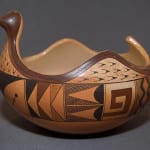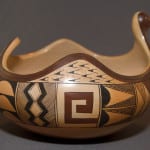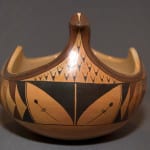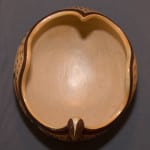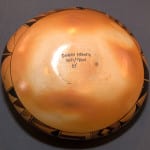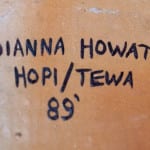Dianna’s brother, Mark Tahbo, taught her pottery; both began their careers by producing many versions of their great grandmother’s Sikyatki butterfly/mesa designs (for Mark, see 1995-01 and 1997-08; for Dianna, see 1992-06). Mark once told me he got “real sick” of painting this design.
This pot has an entirely different spirit—in form and design. While I have seen Hopi pottery swan and chicken baskets made for children around Easter (see Jacka,1974:17), I have never seen a Hopi bird bowl this graceful and modern in form. Wyckoff writes that such “duck bowls” are made at Third Mesa: “Their use appeared to be entirely decorative, and they were usually made as gifts for children. Potters delighted in making these pots, laughing over the expressions of the ducks they created. At First Mesa over Easter weekend, duck- and rabbit-shaped vessels were given out by Kachinas” (1985:89 and plate 5). The ability of kachinas to co-opt an Easter celebration makes me smile, but is also a poignant example of the Hopi/Hopi-Tewa ability to absorb alien traditions and maintain their cultural integrity.
The upward sweep of the tail and wing areas gives bowl 2009-12 an upward thrust. These curves are in tension with the simple linear shape of the neck. The painting reinforces this tension, with the feathers on the wings focused towards the tail and the feathers on the breast and rear focused downward.
A band of frets and traditional Hopi pottery elements encircles the bowl. Overall, the painting is complex but serene. Blushing from the fire is clear, and it helps prevent the finely painted surface from looking like a mechanical decal.
Dianna had a short life, 1960 to 2011, a trend that seems endemic among potters at Hopi. Mark died 6 years after his sister.


